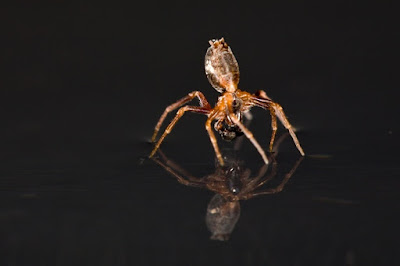If, last week, you’d quizzed me about the dispersal strategies of spiders, I would have told you all about “ballooning”, how Charles Darwin, at sea on the Beagle in 1832, was stunned to see thousands of tiny, dusky red spiders come floating on board, borne on silky parachutes that trapped them in the rigging. This and other observations led him to conclude that “the habit of sailing through the air” was probably “characteristic of this tribe”.
I would not, however, have told you that ballooning spiders can sail on water too, because I didn’t know they did until I read a paper out today in BMC Evolutionary Biology. These sailing skills, documented by Japanese research fellow Morito Hayashi and colleagues, make a lot of sense. Earth, after all, is largely water, so aerial dispersal is not a great idea unless you can cope with the presumably frequent fate of alighting on water.
Working in the “SpiderLab” at the University of Nottingham, Hayashi put hundreds of spiders from more than 20 different species “in a shallow tray filled with water to 1cm height”. When buffeted by “pump-generated air (i.e. wind)”, “spiders actively adopt postures that allow them to use the wind direction to control their journey on water,” he says. They are competent sailors even in salty and turbulent condition, the researchers find.
The paper describes five different water-related behaviours. Here they are:
1) Sailing
Sailing spiders raise their legs to create a kind of sail. “Sailing spiders smoothly and stealthily slide on the water surface without leaving any turbulence,” note Hayashi and co.
2) Upside-down sailing
This demands a “handstand-like posture”, the spider using its abdomen rather than legs to catch the wind.
3) Anchoring
Silk is released onto the surface of the water. This slows down the spider’s movement and may help tether the spider to the relative safety of a floating object
4) Walking
It’s just that, the spider rapidly propelling its legs in an effort to walk on the surface. [Re-reading Darwin’s account of the dusky red spiders he encountered off the coast of South America, it looks like he observed them walking on water: “The little aeronaut,” he wrote in his Journal of Researches, “could run with facility on the surface of water.”]
5) Death mimicry
“Death mimicry behaviour is likely to be a predator avoidance strategy, as is common to many animals.” Essentially, the spider touches the water and freezes. But owing to its water-repellent feet (see the dimples on the surface of the water), it still floats.
In a related investigation, the researchers collected data on ballooning. Those individuals and species that showed a readiness to balloon their way off a dry surface were also the ones with the greatest talent for sailing. “The sailing behaviour is almost completely associated with, and possibly a requirement for, the aeronautic behaviour,” they conclude.
“Being able to cope with water effectively ‘joins the dots’ as far as the spider is concerned,” says Sara Goodacre, head of the SpiderLab and a co-author on the paper. “It can move from one land mass to another, and potentially across huge spatial scales through the air,” she says. “If landing on water poses no problem then in a week or two they could be a long way away from where they started.”
Darwin would have loved this, a neat set of observations that helps explain why spiders are amongst the first to colonise new habitats and why many species are found all the way around the globe. They haven’t just been flying. They’ve been sailing too.



No comments:
Post a Comment